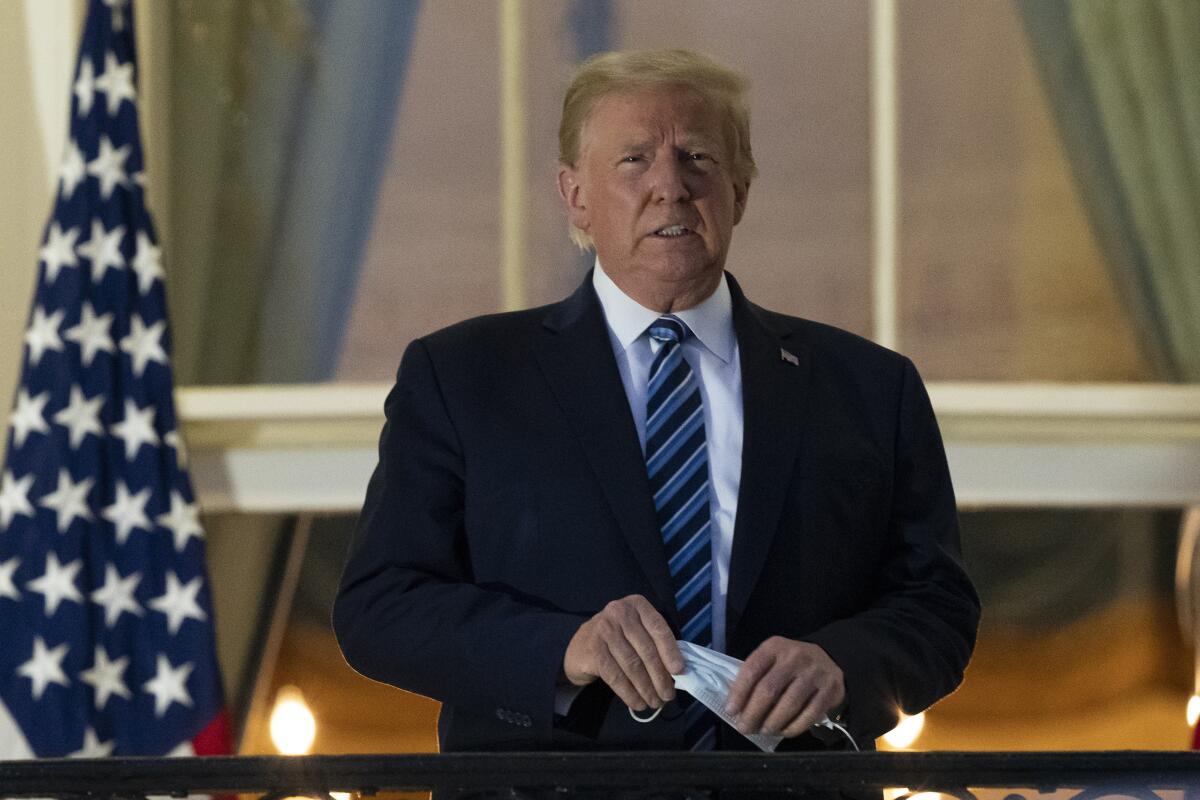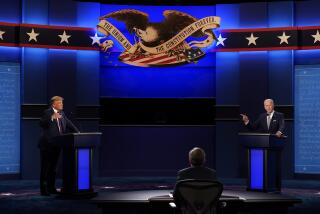Now a COVID-19 hot spot, White House struggles to work

- Share via
WASHINGTON — In a tableau befitting a surreal election season, there may be more raccoons around the White House than actual staff now — and a president with COVID-19 who insisted on marching around the building Wednesday rather than stay in isolation while contagious.
With the iconic white-columned building now a coronavirus hot zone, and a pack of hungry raccoons scratching near reporters on the North Lawn at dawn Wednesday, President Trump escaped the second-floor residence and first slipped into the Oval Office — and then filmed what sounded like a late-night drug infomercial on the South Lawn.
In the five-minute video, he pronounced himself “great, like perfect,” and called his COVID-19 illness “a blessing in disguise,” claiming he would make the experimental antibody drug cocktail given to him available to all Americans.
“They gave me Regeneron. And it was, like, unbelievable. I felt good immediately,” Trump said. Regeneron’s drug cocktail is undergoing clinical trials and has not been approved by federal regulators, so it is not available to the public.
The video marked Trump’s first public appearance since Monday night, when he returned from three days hospitalized at Walter Reed National Military Medical Center.
Trailing in the polls a month before election day, Trump reprised his argument that he shouldn’t be blamed for the pandemic that has killed more than 211,000 Americans in the last six months, more fatalities than in any other country.
“This was China’s fault. Just remember that,” Trump said.
Polls show a majority of voters hold Trump responsible not just for bungling the U.S. response to the pandemic, but also for the growing outbreak inside the White House.
Trump’s uneven performance capped a day when he could not hold himself back. After unleashing a fierce tirade on Twitter, falsely accusing his opponents of treason, he returned to the Resolute desk in the Oval Office.
Mark Meadows, Trump’s chief of staff, and Dan Scavino, a top aide who often runs his Twitter account, kept him company — both wearing full personal protective gear. “I’m on PPE anytime I get close” to the president, Meadows explained.
He didn’t provide details, but anyone in close contact with the president while he has COVID-19 is supposed to wear a medical gown, gloves, mask and eye protection.
Most other top advisors and aides have fled the White House, either because they are infected and under quarantine at home, or worry they soon will be.
Desks have been abandoned as workers in hazmat suits disinfect workspaces and scrub down surfaces. Television reporters who remained on the campus battled raccoons during their live shots.
In a statement before Trump came down from the residence, his physician, Dr. Sean Conley, said the president’s physical exam and vital signs, including oxygen saturation and respiratory rate, remained stable and in normal range.
“He’s now been fever-free for more than four days, symptom-free for over 24 hours, and has not needed nor received any supplemental oxygen” since Friday, when he was rushed to Walter Reed National Military Medical Center, Conley said.
In addition to the president and First Lady Melania Trump, infections have spread rapidly at the White House in the last week, with at least 14 senior aides, staffers, Republican senators, journalists and others who have visited testing positive for the coronavirus.
The list includes boldfaced names such as Press Secretary Kayleigh McEnany, one of Trump’s most prominent defenders on television, and Stephen Miller, his chief speechwriter and the architect of some of his most controversial policies on immigration.
It also includes Kellyanne Conway, who left her post recently as Trump’s chief counselor but returned last week to attend the formal introduction of Supreme Court nominee Amy Coney Barrett, who tested positive over the summer.
The crowded Sept. 26 ceremony, which took place indoors as well as in the Rose Garden, is now seen as a possible super-spreader event.
The infected list also includes lesser-known White House staff who simply showed up to work as press aides and personal valets.
With the election less than a month away, the world’s most famous coronavirus hot spot reminded the nation that Trump’s promises that COVID-19 would disappear “like a miracle” were hollow, and that the virus continues to spread.
Trump tried to counter that reality with a theatrical thumbs-up return to the White House from the hospital on Monday, and a dramatic appearance on the Blue Room balcony in which he took off his mask, in an effort to falsely suggest that he and the country have beaten the pandemic.
The Centers for Disease Control and Prevention recommends people infected with COVID remain in isolation for 10 to 20 days, depending on the severity of the case.
Meadows said earlier Wednesday that the president had been eager to leave his residence in the East Wing.
“If he decides to go the Oval, we’ve got safety protocols there that are not only from the [personal protective equipment] standpoint but from a ventilation standpoint in the Oval,” he said. Social distancing is mandated “as much as practical,” he added.
Until Trump went into the hospital on Friday, he and his top aides were dismissive of such safety protocols, seldom wearing masks in public and holding campaign rallies and events in numerous states, as well as gatherings in the White House.
Trump forced Secret Service agents to take him on a car ride Sunday while he was still a patient at Walter Reed. He wore a mask in the sealed car, as did the agents.
Trump’s doctors have said he tested positive last Thursday and was treated with drug therapies normally used for severe cases. They provided few details about the course of his disease or his treatment, however, and declined to say when he last received a negative test result.
Trump’s aides set up a working area in the residence in hopes he would stay put, as even supporters have warned him to take more precautions. But he clearly was restless.
Among more than 50 tweets he unleashed Wednesday morning, he thanked one supporter who offered to “wade though a sea of COVID infested water to vote for President Trump on November 3rd.”
Other Trump tweets, including one that called mail-in balloting “CORRUPT,” drew warning labels from Twitter for false or misleading content.
More to Read
Get the L.A. Times Politics newsletter
Deeply reported insights into legislation, politics and policy from Sacramento, Washington and beyond. In your inbox twice per week.
You may occasionally receive promotional content from the Los Angeles Times.












